
12 minute read
Brandon Heard
New York, United States
“Hey Mayor, I am gonna be you one day.” Brandon lights up his dark, crowded bedroom with infectious laughter after expressing his genuine conviction to do something significant during his life for his family and community. His mother, Lisa, knew Brandon was special at the age of three, when she saw him giving money to a homeless person who was a familiar face in their public housing development in New York City. “This kid is going somewhere,” Lisa claimed with pride. Now at age 11, Brandon has exceeded all his mother’s expectations, contributing to the community in meaningful ways, despite the challenges of living in poverty.
Advertisement
When people read about urban poverty in the world, they rarely think about families like Brandon’s in the United States. According to most statistics, the United States is one of the richest nations in the world, ranking eighth, for example, on the United Nations Human Development Index in life expectancy, education and gross domestic product indices. However, such statistics do not capture the significant inequalities within “wealthy” countries like the United States, particularly in global cities such as New York, where Brandon and his family live.
To help others understand what living in poverty means in the US context, Brandon agreed to share his story. It highlights the poor living conditions of forgotten Americans like Brandon, but it also celebrates his accomplishments, illustrating the ability of children to make real changes in the communities where they live.

Every school day, Brandon wakes up at the crack of dawn and climbs down from the top level of his bunk bed into a cramped, cluttered, yet clean 10x12 foot room he shares with his 13-year-old brother John and 17-yearold brother Kyle (Figure 4.1).
“Sometimes, I make coffee and bread for my family and surprise them.”
Brandon loves to cook for himself and his family and is proud of knowing how to make arroz con pollo (rice with chicken) (Figure 4.2).
His family - which consists of brothers John and Kyle, mother Lisa, a large German Rotweiler named Tyson, and occasionally, aunt Debbie - all share a small four-room apartment in a 24-storey building in the Stanley Isaacs/ Holmes Towers public housing development, located on the border between Spanish Harlem and the Upper East Side in Manhattan in New York City.

“We take turns eating at the table,” Brandon explains to me, “because there’s not enough space for us all to eat together at one time.” The small kitchen stove is clean yet littered with pots and pans for which there is no storage. Brandon’s mother points to a soccer ball-sized hole in the ceiling of their small kitchen and recounts in detail how many times she has lobbied the New York City Housing Authority (NYHA) to repair this insect and rodent infested area (Figure 4.3).
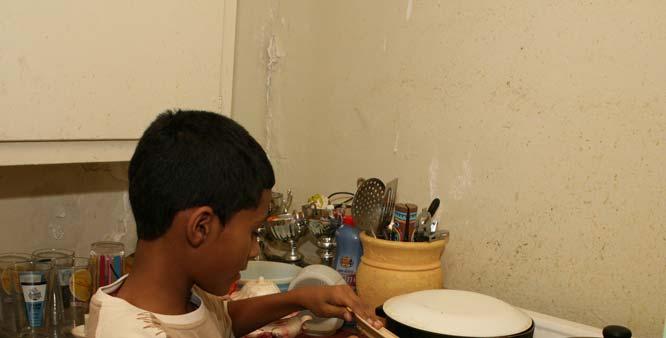
“I don’t know how many times I have raised this issue –maybe eleven or twelve – and nothing has happened. I’ve written letters, spoken to NYHA officials, and now I am at a point where I need to find a lawyer to fight this problem with me.”
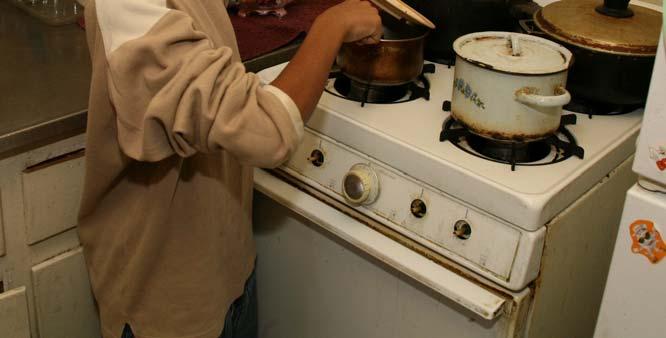
As a single mother, Lisa knows that she is raising her children under difficult circumstances, but does everything she can to empower them to live decent, well-rounded lives.
“We shouldn’t be living in this apartment with all of us, but we are on a waiting list for a new larger place.”

The overcrowded conditions of the apartment, which is about 500 square feet, are evident to Brandon, who when asked what he would change about his home stated, “I would make it wider, with more space, and I would like my own room” (Figure 4.4). Brandon admitted that when I asked him to draw a map of his home, he made the rooms look bigger than they really are. With little closet space, the family stores items in an efficient way.

As Brandon puts it, “we have a lot of buckets. My clothes are in a bucket in the living room, my mom’s bucket is in the hallway.”

Buckets are plastic covered, movable storage containers that stack on top of one another, enabling the family to keep some order in their cramped living quarters.
Despite the crowded conditions of Brandon’s home, he speaks fondly of his life with his family and was proud to take me on a treasure hunt inside his buckets, “one of the world’s largest toy boxes,” to point out favorite toys and all the trophies he and his family have accumulated in tai quan do, a form of martial arts Brandon has been practicing since the age of three (Figure 4.5). “I wish I had a rug where I could sit and play,” he chuckles, “because Tyson (the dog) always takes over this rug.” Brandon easily transforms his cramped bedroom and home into a play land, where games of hide-n-seek do not require much space, but ask for creativity to find new secret locations in which to disappear.

Neighborhood
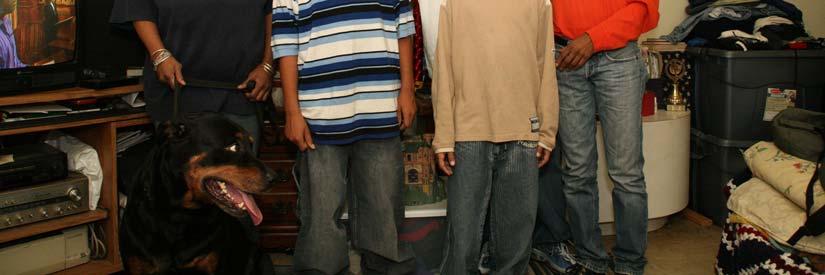
Space is a premium in New York City. For poor families like Brandon’s living in public housing developments, there is a long line of needy people waiting for a home.
When the Stanley Isaacs/Holmes Towers public housing development was built in 1963, there was already a high demand for affordable housing among the predominantly Italian, German and Irish working class families in the surrounding neighborhood. Since the early 1950s, the Upper East Side has witnessed relentless gentrification, as developers and private investors destroyed many tenements block by block, displacing working class families and replacing walk-up tenements with 30 to 50 storey luxury buildings housing upwardly mobile professionals (Figures 4.6 and 4.7).

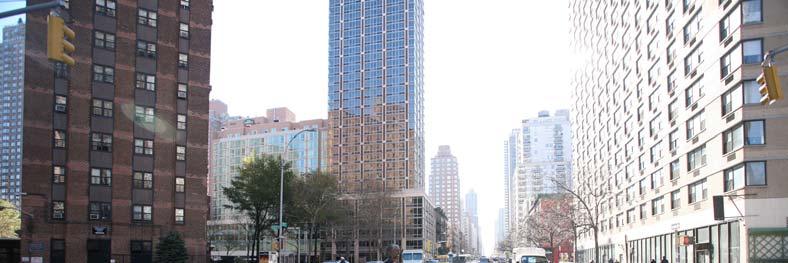
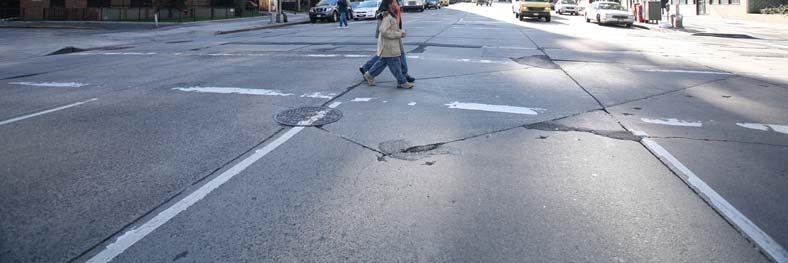

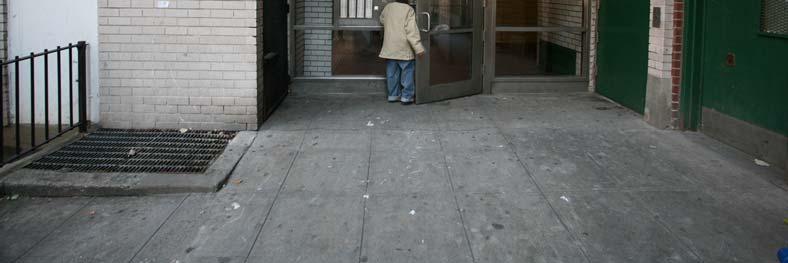
Residents often mobilized themselves to combat the forces of gentrification, forming anti-gentrification committees and developing strategies to retain their homes, such as passing on apartment leases from generation to generation. Such efforts were largely ineffective.
From 1951 to 1960, some 15,000 families were driven from their homes. From 1980 to 1990, there was a 12% loss in housing comprising 10-19 units (tenement buildings) and a 15% increase in housing comprising 50 units or more (luxury apartments). The Stanley Isaacs/Holmes Towers became a refuge for working-class families in the neighborhood, and later on, for families like Brandon’s who were randomly placed in the development through a computerized tenant selection process employed by the New York City Housing Authority. The result is an economically polarized community in which there is a difference in median family income of over $100,000 from one side of the street to the next.
“I see people walking around on top of their buildings, with trees and stuff,” Brandon acknowledges when I asked about his wealthy neighbors. Brandon largely ignores “the other half” of his community, where he observes rooftop gardens from his bedroom window, or at least does not give much thought to the social division. As a result of the gentrification of the Upper East Side, poorer residents have witnessed a sharp reduction in their quality of life. Grocery stores which now cater to different culinary desires and tastes are often too expensive for poorer residents, leaving many to travel greater distances to the north into East Harlem for food, clothing and everyday living needs. In addition, many of the 50 storey luxury buildings have blocked the view residents used to have of the sun and of the East River. Some important childhood spaces have been gentrified from abandoned lots to expensive luxury recreational facilities. Policing of the neighborhood in- cludes aggressive monitoring of public housing residents who are largely Puerto Rican and African American, as opposed to their wealthier, white neighbors.
People and Places Important in Brandon’s Everyday Life
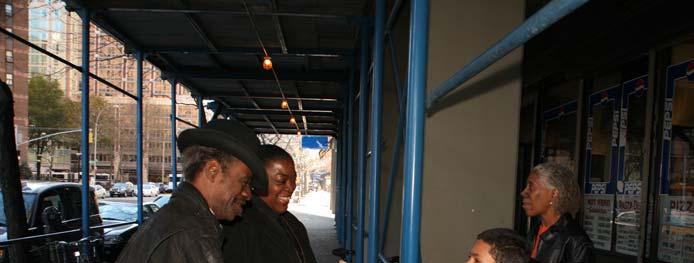
To Brandon, his neighborhood and the people living there are the most important things in his life, despite all the recent changes and polarities. “I see new kids moving in here all the time,” Brandon observes astutely, priding himself on knowing almost everyone in his building and community (Figures 4.8 and 4.9).
Brandon has friends in almost every building of the Stanley Isaacs/Holmes Towers, whom he has met from playing in Batman Park (a popular playground in the development), through his mother’s social networks, or from playing in his building, walking Tyson the dog (Figure 4.10), and attending programs at the Isaacs Community Center.

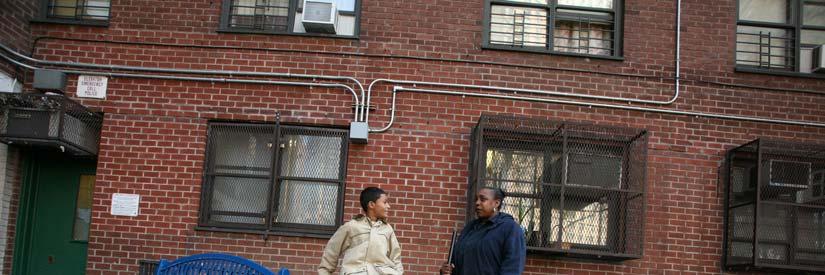

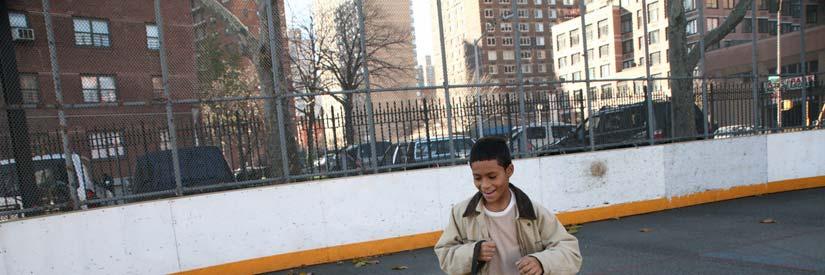

Brandon also has a range of adult role models in the community, such as his godparents Genesis and Sabrina, a foster mother of about 10 children in the community named Olga, and his neighbor Carmen who teaches Brandon Spanish. Brandon’s rich social networks reflect his role as a “caretaker” of other people in the neighborhood and also his sense of belonging to a place that is easier to negotiate with the support of others, rather than as an isolated individual or family group.
“In the morning it [the community] is busy with rush hour and on Sundays I can hear noise from all the construction. In the afternoon it is peaceful and I can go for a walk, but in the evening it is hectic, but you can hang outside with your parents and play with friends and no one bothers you. In Batman Park I go bike riding, listen to birds chirping and sit with my mom and aunt. I also help baby-sit little kids in the park who want to learn how to use the slides.”
At the age of 11, Brandon prides himself in looking out for others, such as his friend Devante, with whom he often plays ball on a concrete surface in the development (Figure 4.11).
One of Brandon’s favorite places to go is the pizzeria across the street from his building called Francesca’s. “Sometimes I get free pizza from the owner,” Brandon laughs (Figure 4.12).
Brandon knows the rhythm of his community and how to get around without much trouble, largely because he is on good terms with many people.
“I don’t want me or anyone I know getting shot, because the world is getting too dangerous,” Brandon worries. According to Lisa, Brandon’s fears about his community are valid.
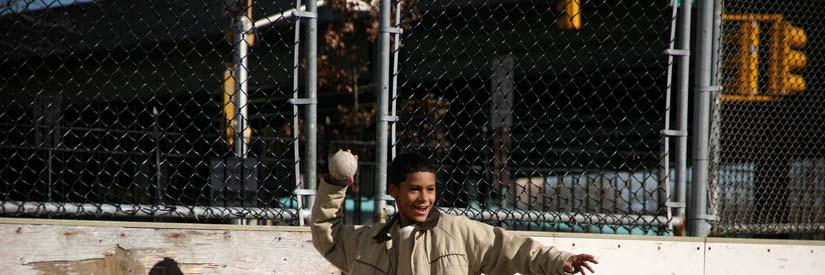
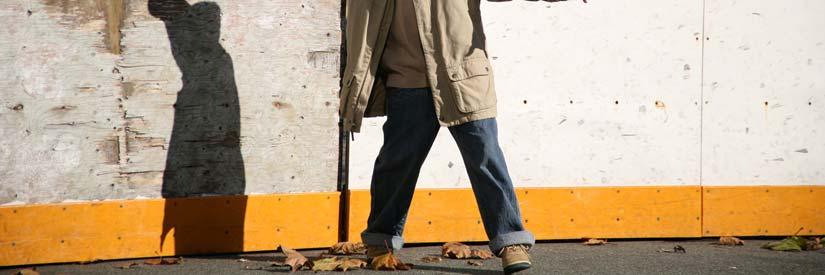
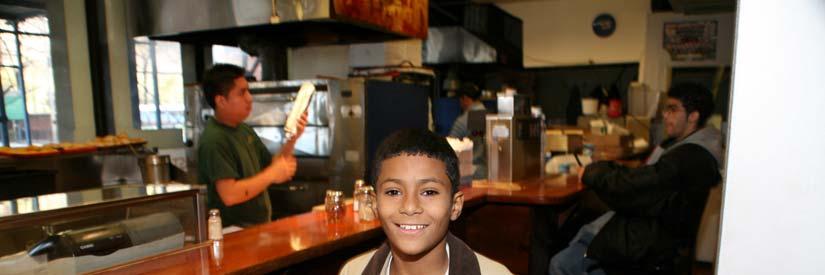
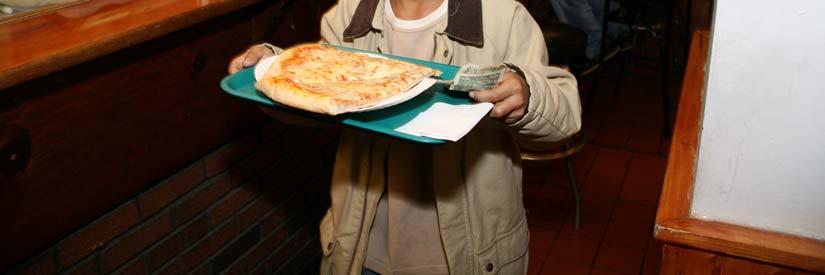
“It’s a hell of an experience raising a child here – you need to teach your kids street smarts to keep them out of trouble and to avoid peer pressure to join gangs and do drugs.”
At first Brandon tells me he would not change anything about his community. But, after a long pause, he abruptly changes his mind.
“I think everyone should stop selling drugs and stop the gun shots. I think the neighborhood could be cleaner, and I hope more people could learn to get along with one another and be nicer.”
Perhaps this statement reflects Brandon’s newfound intimacy with his neighborhood. For the first time this summer, Brandon was allowed to go places in his neighborhood alone or with friends. He is required to check in with his mother every half hour by going up to his 23rd floor apartment (Figure 4.13). His mother says:
“You pray that all the morals and values you taught them –you hope they take it with them. Keeping your kids in the right direction is not easy.”
Brandon’s Role in the Community
The potential social hazards in the community are substantiated by other residents who work hard to provide alterative opportunities for children and youth living in the neighborhood. However, Lisa’s childrearing has paid off. Brandon is known as a leader in the community, both informally as a “caretaker” of other children and youth, but also formally through his work with a community-based organization. The Isaacs Center, a settlement house based on the tradition of Jane Addams’ Hull House in Chicago, provides social services to residents of the public housing development, ranging from computer training for youth to providing meals to elders with physical disabilities6.

Brandon participates in a variety of programs at the Isaacs, but one in particular – Take Action! – is focused on community improvement projects. In the past, the young people in Take Action have helped to plant trees in the neighborhood, and have done research about who used a neighborhood park to give their ideas for its redesign. Brandon also tutors young children in reading, writing and math alongside his mother and aunt. Together they have helped numerous young people improve their performance at school. Brandon says:
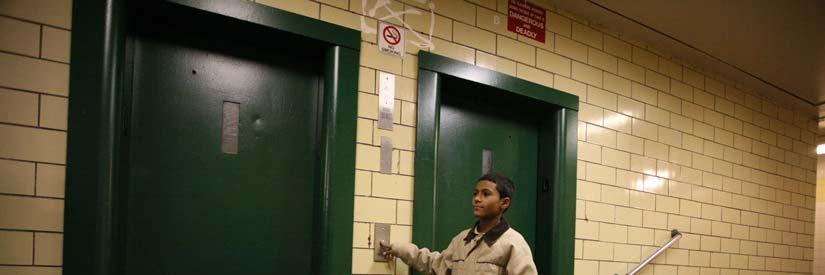
“I make blankets for the elderly and homeless in the community and I gave a speech one time about why I liked the Isaacs Center. Because of me, more parents brought their kids to the Center. I told them they should bring their kids here because the Center will support you and will help your children.”
Brandon’s work with the Isaacs Center has been recognized by the adults and children he helps. He has written articles for the community newsletter, volunteers for projects without prompting, and shares his knowledge with young people he mentors. Recently, Brandon joined its Youth Management Team, a group of young people who create and implement community projects, in New York and elsewhere around the world. In his new role, he testified at a series of public hearings to oppose the creation of a waste transfer facility in his neighborhood (Figure 4.14).
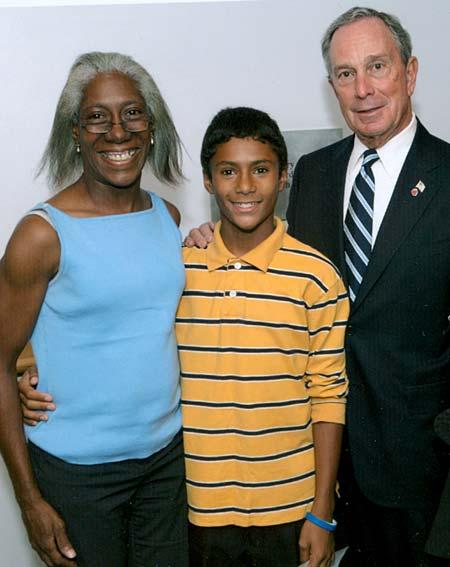
Talking about this experience, he says:
“Just think of all the smell and rats and bad things that will come with this facility. Think about the kids that live and grow up here.”
Brandon also helps out in the community outside the Isaacs Center, for example, by baby-sitting and playing with Olga’s foster children. “In the future, I hope to be successful and stay in school to get a good education so that when my mom gets older, I can help her out.” While Brandon loves his community, he often wonders if it would be better to live somewhere else.
“I want to live somewhere else like Florida, California or even Jamaica when I grow up, in a place that is relaxing.” Like many children living in poverty, daily life is riddled with uncertainty and joy, a paradox that often can be stressful and confusing. Despite this fact, Brandon is sure of his future successes and knows one person can make a big difference. “I want to be a lawyer when I grow up - or maybe the mayor, so I can help other people.”
Endnotes
1. Edited field report prepared by Pamela Wridt. Photographs by Scott Wynn.
2. United Nations Development Program (UNDP), (2006). Human Development Report 2006, New York: Palgrave Macmillan, retrieved on April 6, 2007 from http://hdr.undp.org/ en/media/HDR06-complete.pdf.
3. Jacobs, J. (1992[1961]). The Death and Life of Great American Cities. New York: Vintage Books, p. 137.
4. City of New York, Department of City Planning. (1992). Demographic Profiles: A Portrait of New York City’s Community Districts from the 1980s & 1990 Censuses of Population and Housing. New York: Department of City Planning.
5. Wridt, P. (2004). Childhoods in Place and Placeless Childhoods: An Historical Geography of Young People in Yorkville and East Harlem, 1940-2000. New York: City University of
Conclusion
As we approach the 20th anniversary of adoption of the UN Convention on the Rights of the Child in 2009, these children are our best hope for the future. Their lives represent the potential of people living in poverty, whose empowerment offers what is the single best prospect for improving urban livability in today’s world. Their stories hold a message about poverty and prosperity – and the differences between them. They convey despair about wasted and lost lives. But they also show resilience, bring hope and raise expectations for the future of children everywhere.
Indeed, in the words of Mrs. Anna Tibaijuka, Under-Secretary-General of the United Nations and Executive Director of its Human Settlements Programme:
“…youth are a resource, in fact the most important and strategic resource a country can have. Youth are agents of social change; they take on a very active role in addressing the issues that affect them. We have examples of many youth led processes that are working and making a difference in society even with minimal resources. What is required is to provide these initiatives with an enabling environment that will facilitate their replication”.19
Required, as well, is research to provide evidence-based guidance to the formulation of policies that create the enabling environments for initiatives aimed at eradicating child poverty. Studies, such as being conducted through the Young Lives project in Ethiopia, India, Peru and Vietnam, are encouraging.20 We need quantitative and qualitative data on the conditions and effects of poverty, and the evaluation of poverty reduction strategies. We also need to listen to the voices of children themselves in efforts to improve children’s well-being. This report seeks to mobilize support for such inclusionary practices.
References
Asian Development Bank. (ed.). 2003. If I Had the Chance...Artwork from the Streets of Asia and the Pacific. Manila: Philippines: ADB.
Chawla, L. (ed.). 2002. Growing Up in an Urbanising World. London: Earthscan/UNESCO.
Commonwealth Secretariat. n.d. The Commonwealth Plan of Action for Youth Empower ment, 2007-2015. London: Author
Copsey, Susan Elizabeth and Barnabas Kingsley. 1995. Children Just Like Me. UNICEF.
Kindersley, Anabel and Barnabas Kindersley. 1997. Children Just Like Me: Celebrations!. UNICEF.
Kindersley, Dorling. 2002. A Life Like Mine. UNICEF.
Kinkade, S. and C. Macy. 200 Our Time Is Now: Young People Changing the World.
Kirschke, J. and W. van Vliet- . 2005. “How Can They Look So Happy?” Reconstructing the Place of Children after Hurricane Katrina: Images and Reflections. Children, Youth and Environments 15(2): 378-391.
Minujin, A., E. Delamonica, A. Davidziuk, and E.D. Gonzales. 2006. The definition of child poverty: a discussion of concepts and measurements. Environment and Urbanization Vol. 18, No. 2, 481-500.
Montanari, Donata. 2001. Children Around the World. Kids Can Press
Narayan D. Bonds and Bridges. 1999. Social Capital and Poverty. Washington DC: The World Bank Policy Research Working Paper No. 2167
Satterthwaite, David. 2002. Reducing Urban Poverty; Some Lessons from experience. Lon don: international Institute for Environment and Development, Working Paper 11.
UN-HABITAT. 2006. State of the World’s Cities, 2006-2007. London: Earthscan.
UNFPA. 2007. Framework for Action on Adolescents and Youth. New York: United Nations Population Fund.
United Nations Children’s Fund. 2002. A World Fit for Children. New York: UNICEF
United Nations Children’s Fund. 2004. Building Child-Friendly Cities: A Framework for Ac tion. Florence: UNICEF, Innocenti Research Centre.
Van Vliet-, W. 2002. Cities in a globalizing world: from engines of growth to agents of change. Environment and Urbanization 14(1): 31-40.





